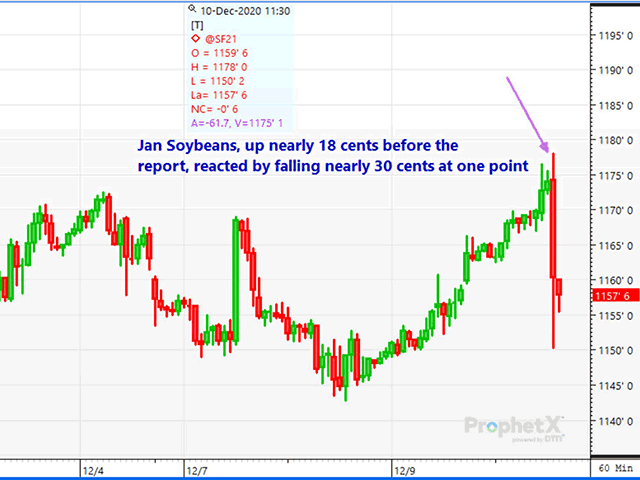USDA Reports Review
Corn and Soybean Gains Prior to WASDE Dissipate After Report
The Dec. 10 World Agricultural Supply and Demand Estimates (WASDE) report, which was not expected to be a big market mover, seemed to disappoint bullish traders when U.S. soybean ending stocks fell less than expected and corn stocks remained unchanged. The fact that only soybean crush and not exports were increased was a mild surprise to many. Perhaps the biggest surprise in the report was the fall in world wheat ending stocks by 4 million metric tons (mmt), as China feed wheat consumption and imports were increased by a combined 3.5 mmt.
Let's take a closer look at both U.S. and world numbers from Thursday's report.
SOYBEANS
It is hard to find a person who did not think that the report would increase U.S. soybean exports based on the torrid record pace of sales, which already account for nearly 88% of the current projection. Bullish traders were disappointed when WASDE decided to leave exports untouched but raised crush by 15 million bushels (mb). The resulting ending stocks level of 175 mb was about 10 mb higher than the average pre-report trade estimate and higher than where many think it could ultimately go. Ending stocks are still the lowest since 2013-14.
On the world front, WASDE chose to leave Brazilian bean production at a record-large 133 mmt (4.88 bb), while reducing Argentine soybean production by 1 mmt to 50 mmt. China's soybean imports were left unchanged at 100 mmt (3.67 bb). With global ending soybean stocks falling from 86.52 mmt in November to 85.64 mmt (3.1 bb), the report came in close to what the trade had expected.
Season average price on soybeans was increased 15 cents to $10.55 per bushel. The season average for soymeal was raised $15 to $370 per ton, and the average soybean oil price was boosted by 1.5 cents to 36 cents per pound.
P[L1] D[0x0] M[300x250] OOP[F] ADUNIT[] T[]
The report was mostly neutral for soybeans with many traders still expecting the U.S. and world balance sheet to tighten. With a long time to go in South America's growing season, USDA was hesitant to make any major changes this early.
CORN
Traders had anticipated that U.S. corn ending stocks were likely to fall by about 11 mb from the November WASDE report. Instead, corn ending stocks remained completely unchanged at 1.702 bb. Some were likely surprised that a small bump in exports did not happen.
On the world front, Ukraine corn production was increased by 1 mmt to 29.5 mmt, while China corn imports were raised from 13 mmt to 16.5 mmt. China's feed usage of corn was increased by a like amount to 198.5 mmt (7.8 bb) from November. The net effect of the changes was that world corn ending stocks fell by 2.4 mmt from November to 289 mmt (11.4 bb) -- about what traders had expected.
The report left Brazilian corn production unchanged at 110 mmt (4.3 bb), despite the dryness of the past several months. Brazil's ag agency, CONAB, earlier in Thursday morning had put Brazil's production at just 102.6 mmt (4.03 bb) -- nearly 7.5 mmt below WASDE. Argentina's crop was reduced by 1 mmt to 49 mmt (1.93 bb).
The net effect of these changes was a world ending stocks number of 289 mmt (11.4 bb), down 2.4 mmt from November and about what the trade had expected prior to the report. It was an overall neutral report for corn.
WHEAT
Any wheat changes on the domestic side in December's WASDE were expected to be mild. Estimating an ending stocks number of 874 mb, the stocks fell more than expected to 862 mb. An increase in white wheat exports by 20 mb and decrease in hard red winter wheat exports of 10 mb led to the 862 mb ending stocks number -- a gain of 10 mb. Exports were increased to 985 mb.
On the global front, we saw some more significant changes. Global wheat production rose to a new record high of 773.7 mmt (28.4 bb). Australian production was increased by 1.5 mmt to 30 mmt. Canada's crop rose to 35.2 mmt. Wheat consumption rose by 5.1 mmt due to China, Australia and the EU increasing feed usage of wheat. China wheat imports were increased by 500,000 mt to 8.5 mmt and the largest since 1995-96. China's feed usage of wheat was increased by 3 mmt to 24 mmt (881 mb), accounting for most of the 3.9 mmt decline in world stocks to 316.5 mmt (11.66 bb). Traders had expected an ending stocks number about 5 mmt higher than that.
The report was slightly bullish for wheat. However, wheat was higher before the report than where it closed on Thursday.
MARKET WRAP-UP
Following what was considered a mostly neutral WASDE report for corn and soybeans, both finished lower Thursday and well under the morning highs. Wheat futures closed higher as the world ending stocks declined by 4 mmt. March corn finished 2 1/2 cents lower, January beans closed down 5 3/4 cents and Kansas City March wheat closed 12 1/2 cents higher.
Dana Mantini can be reached at dana.mantini@dtn.com
Follow Dana Mantini on Twitter @mantini_r
(c) Copyright 2020 DTN, LLC. All rights reserved.




